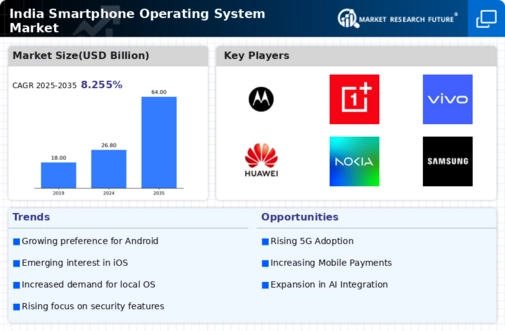The smartphone operating-system market in India is characterized by intense competition and rapid technological advancements. Key players such as Apple (US), Google (US), and Xiaomi (CN) are actively shaping the landscape through innovative strategies and operational focuses. Apple (US) continues to emphasize premium product offerings and ecosystem integration, while Google (US) is leveraging its Android platform to enhance user experience and expand its market share. Xiaomi (CN), on the other hand, is focusing on affordability and feature-rich devices, appealing to a broader consumer base. Collectively, these strategies contribute to a dynamic competitive environment, where differentiation is increasingly driven by innovation and user-centric approaches.
In terms of business tactics, companies are localizing manufacturing to reduce costs and improve supply chain efficiency. This approach is particularly evident in the smartphone operating-system market, which is moderately fragmented, with several players vying for market share. The collective influence of these key players is significant, as they engage in strategic partnerships and collaborations to enhance their operational capabilities and market reach.
In October 2025, Apple (US) announced the launch of its latest iOS update, which includes advanced privacy features and enhanced integration with its hardware ecosystem. This move is strategically important as it reinforces Apple's commitment to user privacy, a growing concern among consumers, and positions the company favorably against competitors. By enhancing its operating system, Apple (US) aims to solidify its market position and attract privacy-conscious users.
In September 2025, Google (US) unveiled a new initiative aimed at improving the Android experience for Indian users, focusing on localized content and services. This strategic action is significant as it demonstrates Google's commitment to catering to the unique needs of the Indian market, potentially increasing user engagement and loyalty. By tailoring its offerings, Google (US) seeks to strengthen its foothold in a highly competitive environment.
In August 2025, Xiaomi (CN) expanded its partnership with local manufacturers to enhance its supply chain capabilities and reduce production costs. This strategic move is crucial as it allows Xiaomi (CN) to maintain its competitive pricing strategy while ensuring product availability. By optimizing its supply chain, Xiaomi (CN) is likely to improve its market responsiveness and sustain its growth trajectory in the Indian market.
As of November 2025, current trends in the smartphone operating-system market include a strong emphasis on digitalization, sustainability, and AI integration. Strategic alliances are increasingly shaping the competitive landscape, as companies collaborate to leverage each other's strengths. Looking ahead, competitive differentiation is expected to evolve, with a shift from price-based competition to a focus on innovation, technology, and supply chain reliability. This transition may redefine market dynamics, compelling companies to invest in cutting-edge technologies and sustainable practices to maintain their competitive edge.

























Leave a Comment